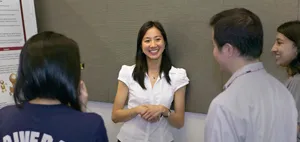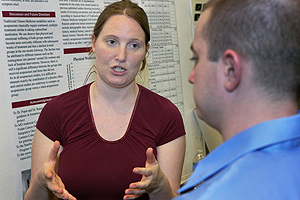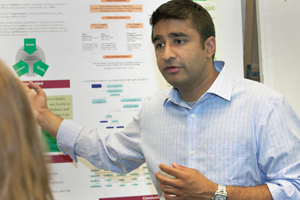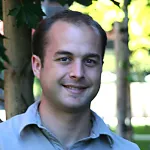
Inside Stanford Medicine - May 24th, 2010 - by Tracie White
It’s long been known that young children who have liver transplants often develop learning problems as they grow up. Emily Johnston, a fourth-year medical student headed to a pediatrics residency at Stanford, wanted to know more about why this happens.
At the 27th annual Stanford Medical Student Research Symposium on May 13, Johnston’s research effort was among the 37 projects on display that explored contemporary health problems.
Johnston’s poster project examined possible causes of low IQ scores and poor school performance among children who underwent a liver transplant before the age of 3.
“We know that a lot of children who have liver transplants end up in special education,” said Johnston, a 28-year-old native of Iowa. “I wanted to help provide more information to parents to prepare for this and, perhaps, help prevent it.” Johnston gathered data on 54 Stanford patients who underwent liver transplants before the age of 3. All 54 are now between 13 and 18 years old.
Her data showed that 35 percent of the transplant patients required additional support in school. The next stage of the project is to do a statistical analysis of the possible risk factors for the learning problems, such as the inability of the liver to breakdown chemicals that are toxic to the brain, frequent hospitalizations and immunosuppressants that lead to poor developmental outcomes.
“Survival rates for liver transplants are great, about 85 percent now,” Johnston said. “I’ve always been interested in the larger context of medicine and how it goes on to affect quality of life.”
Examining medicine in a “larger context” was a theme of many of the projects, which touched on a variety of health-care issues, from examining the characteristics of adolescents at risk for bipolar disorder to brain-controlled prostheses to the health outcomes of patients with chest pain in India.
Students, staff and judges crowded the rows of posters set up in a conference room of the medical school’s new Li Ka Shing Center for Learning and Knowledge, discussing the cholesterol content in cochlear hair cell membranes or the use of functional MRI brain imaging to control chronic pain or electronic support for diabetes and hypertension care in Tanzania. Five awards were given for outstanding poster/abstract presentations.
“In Tanzania, you’ll walk five miles to see a physician when you’re sick,” said Sumit Shah, 28, who together with Meera Sridhar, 27, both fourth-year medical students, spent a month in Tanzania studying the need for better care of patients with diabetes and hypertension.
There’s a growing epidemic of these chronic diseases in the developing world that needs to be addressed — and quickly, Shah and Sridhar said. But most of the focus is still on infectious disease, in part because care for patients with chronic disease requires follow-up and expertise that is difficult to provide in areas where supplies and resources are limited.
The two students developed electronic algorithms downloadable to cell phones for use by nurses in rural clinics who treat and screen patients for diabetes and hypertension, but don’t have the expertise to do follow-up care. The cell-phone-accessed information can both store data on patients and provide medical advice that has been translated into Swahili.
“I really think telemedicine is going to be the wave of the future,” Shah said.
Inspired by the Stanford biodesign process of innovation, Lauren Chan, 28, another fourth-year student, joined a team of two medical students and one medical engineer to design a new way to reduce stroke risk in patients with atrial fibrillation (abnormal heart rhythm). There are currently 2.6 million people with the condition in the United States and the percentage is increasing as the population ages, Chan said. The current preferred treatment method is long-term medication that patients often don’t like and that can cause worrisome side effects.
“We wanted to come up with a better method for stroke reduction than what is now available,” Chan said.
Atrial fibrillation can cause blood clots to form in the left atrium of the heart that then travel to the brain, causing stroke, said Chan. The team’s proposal is a new, minimally invasive surgical procedure that would completely seal off the left atrium of the heart using a balloon system to guide the use of a suture to tie off the leakage in the heart. The next step is to prototype these designs.
Medical student research symposium winners
Five students received awards for outstanding poster/abstract presentations from the 27th annual Medical Student Research Symposium on May 13. The students and their mentors will be honored at a dinner hosted by the Stanford University Medical Center Alumni Association:
- Nathan Meng, “Pre-clinical validation of a portable infant warmer using phase-change material not dependent on acontinuous external supply of energy.” Mentor: Vinod Bhutani, MD, professor of neonatology.
- Paul Nuyujukian, “A high-performance cortically-controlled motor prosthesis enabled by a feedback control perspective.” Mentor: Krishna Shenoy, PhD, associate professor of electrical engineering.
- Hersh Sagreiya, “Extending and evaluating warfarin pharmacogenetic algorithms using CYP4F2 and rare variants in CYP2C9.” Mentor: Russ Altman, PhD, professor of bioengineering, genetics and medicine.
- Jane Whitney, “Neuropsychological characteristics of children and adolescents at risk for bipolar disorder.” Mentor: Kiki Chang, MD, professor of child and adolescent psychiatry.
- R. Tyler Hillman, “Neuropilins are essential positive regulators of mammalian hedgehog signaling.” Mentor: Matthew Scott, PhD, professor of developmental biology, genetics and bioengineering.

